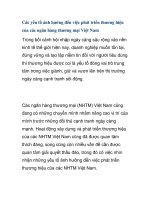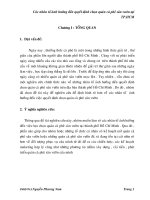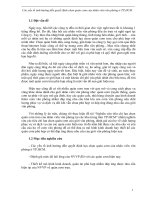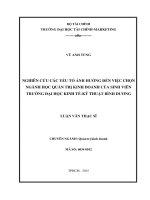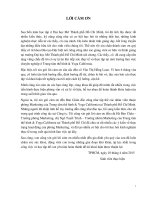CÁC YẾU TỐ ẢNH HƯỞNG ĐẾN VIỆC CHỌN NGÀNH MÔI TRƯỜNG CỦA SINH VIÊN KHOA QUỐC TẾ ĐẠI HỌC THÁI NGUYÊN
Bạn đang xem bản rút gọn của tài liệu. Xem và tải ngay bản đầy đủ của tài liệu tại đây (637.25 KB, 7 trang )
<span class='text_page_counter'>(1)</span><div class='page_container' data-page=1>
<b>FACTORS AFFECTING THAI NGUYEN UNIVERSITY </b>
<b>INTERNATIONAL STUDENTS' ENVIRONMENTAL SPECIALIZATION </b>
<b>Cao Thi Nhung Trang*, Nguyen Thi Hoa</b>
<i>TNU - International School</i>
<b>ARTICLE INFO </b> <b>ABSTRACT </b>
<b>Received: </b> <b>14/4/2021</b>To ascertain the factors influencing Thai Nguyen University International
students' choice of environment major, the research group chose 21 variables
to investigate and classified them into four primary research groups: "Faculty
Fixed Characteristics", "Faculty Communication Effort", "Students'
Self-Characteristics", and "Influential Individuals". Cronbach's Alpha, exploratory
factor analysis (EFA), and multivariate linear regression were used in this
study. The participants included 134 students majoring in Environment. The
results show that 81.5% of students' decision to choose an environmental
major is influenced by the above four groups of factors. In which, the
decision to choose the environment major of international students increased
to 0.419 units when the fixed characteristics of the Faculty increased to 1 unit;
increased by 0.306 units when Faculty's communication effort increased by 1
unit; increased to 0.126 units when the student's personal characteristics
increased by 1 unit and increased by 0.337 units when the individual of
influence increased to 1 unit. As a result, in order to increase the number of
students enrolled in the environment major, the School must enhance its work
in the following areas: strictly handle the factors that make up the
International School's fixed features, reinforce efforts to propagate and
facilitate, develop a team of professional admission advisors, and cultivate a
friendly relationship between the International School and associated areas.
<b>Revised: </b> <b>18/5/2021</b>
<b>Published: </b> <b>21/5/2021 </b>
<b>KEYWORDS</b>
Factor
Influence
Environment
Decision
Enrollment
<b>CÁC YẾU TỐ ẢNH HƯỞNG ĐẾN VIỆC CHỌN NGÀNH MÔI TRƯỜNG </b>
<b>CỦA SINH VIÊN KHOA QUỐC TẾ ĐẠI HỌC THÁI NGUYÊN </b>
<b>Cao Thị Nhung Trang*, Nguyễn Thị Hoa </b>
<i>Khoa Quốc tế - ĐH Thái Ngun</i>
<b>THƠNG TIN BÀI BÁO </b> <b>TĨM TẮT </b>
<b>Ngày nhận bài: </b> <b>14/4/2021 </b>Để xác định được các yếu tố ảnh hưởng đến việc chọn ngành Môi trường của
sinh viên Khoa Quốc tế, nhóm nghiên cứu đã chọn 21 biến để nghiên cứu và
chia làm 4 nhóm giả thuyết nghiên cứu chính: “Đặc điểm cố định của Khoa”,
“Nỗ lực giao tiếp của Khoa”, “Đặc điểm bản thân sinh viên” và “Các cá
nhân có ảnh hưởng” trên 134 sinh viên ngành Môi trường. Phương pháp
kiểm định Cronbach’s Alpha, phân tích nhân tố khám phá (EFA) và hồi quy
tuyến tính đa biến được sử dụng trong nghiên cứu này. Kết quả cho thấy
81,5% quyết định chọn ngành Môi trường của sinh viên Khoa Quốc tế chịu
sự ảnh hưởng bởi 4 nhóm tố trên. Trong đó quyết định chọn ngành Môi
trường của sinh viên tăng lên 0,419 đơn vị khi đặc điểm cố định của Khoa
tăng lên 1 đơn vị; tăng lên 0,306 đơn vị khi nỗ lực giao tiếp của Khoa tăng
lên 1 đơn vị; tăng lên 0,126 đơn vị khi đặc điểm bản thân học sinh tăng lên 1
đơn vị và tăng lên 0,337 đơn vị khi cá nhân có ảnh hưởng tăng lên 1 đơn vị.
Do đó, để nâng cao cơng tác tuyển sinh ngành Môi trường Khoa cần nâng
cao các công tác: Quản lý chặt chẽ các yếu tố tạo nên đặc điểm cố định của
Khoa, tăng cường nỗ lực tuyên truyền và quảng bá, xây dựng đội ngũ cán bộ
tư vấn tuyển sinh chuyên nghiệp, thiết lập mối quan hệ hữu hảo giữa Khoa
với các đối tượng hữu quan có liên quan.
<b>Ngày hồn thiện: </b> <b>18/5/2021 </b>
<b>Ngày đăng: 21/5/2021 </b>
<b>TỪ KHÓA</b>
Yếu tố
Ảnh hưởng
Môi trường
Quyết định
Tuyển sinh
<b>DOI: </b>
*
</div>
<span class='text_page_counter'>(2)</span><div class='page_container' data-page=2>
<b>1. Introduction </b>
Identifying the factors affecting students’ choices of majors does not only help them to orient
their future careers but also assist training institutions have effective student recruiting solutions.
Joseph Sia Kee Ming [1] proposed a conceptual framework model of factors influencing students'
decision to choose a university in Malaysia. The research results have shown that a student's
decision to choose a university is influenced by a factor group of fixed university characteristics
and the group of factors of communication efforts with students. The model proposed by the
author only introduces factors that can affect the decision to choose a university. Russayani
Ismail [2] completed a case study of foreign students at Utara University Malaysia on the subject
"Factors Influencing the Choice of Educational Destination." The research emphasized the
importance of preserving educational quality to ensure long-term competitiveness and seeks to
identify factors that may impact foreign students' decision-making when selecting a university.
However, this research is only applicable to universities that educate foreign students [2].
MeiTang, WeiPan [3] researched the factors that affect to the choosing university trends of high
school students. The research analyzed 4 main factors such as: experiential learning, ability to
evaluate career capabilities, benefits and expected outcomes in career development. All the
factors effect to the students' career choices from high school students. This research only focuses
on orientation of the students’ future careers. Bromley [4], who polled 384 teens, came to the
conclusion that both school and family have a direct or indirect influence on young people's
career decisions. There is also the influence of siblings, relatives, and friends,... This survey just
shows the individual groups affecting students’ choices of majors. Similar to Bromley’s research,
Michael Borchert [5] conducted a poll of 325 high school students at Germantown High School
in Wisconsin, USA, and found that the three key groups of factors that impact career decisions
are environment, opportunities, and personal traits. The research findings show that personal
factors have the most significant impact on high school students’ choice of careers. D.W.
Chapman [6] suggested a general model of university selection for students. During the surveying
process to test the model, two groups of factors were discovered to have a significant impact on a
student's decision to attend a university: family characteristics, individual student and side
factors, as well as personal impacts such as fixed university characteristics and the university's
attempts to interact with students. According to the findings of Ha's research "Factors Affecting
Students' Choice of Ho Chi Minh City Open University”, there are seven factors that influence
students' school choices, all of which are interconnected. However, the study findings still have
up to 7 groups of factors influencing the decision, making those findings impossible to apply in
practice [7]. Tran Van Qui and Cao Hao Thi conducted research on "Factors Influencing High
School Students' Decision to Attend University." According to the findings, five factors influence
students' decisions to choose universities: future employment opportunities factors, fixed
qualities of the university, factors about the student's individual identity; personal factors
influence students' decisions, and available information influences their decision to choose
universities. When scaled to the population, this model only describes 21.5 percent of study
challenges [8]. To identify all factors affecting to students’ choice of majors and their level of
influences, we conducted a research on factors affecting the students’ choices of environmental
specilization at International School.
<b>2. Materials and methods </b>
The research model was performed according to the figure 1.
</div>
<span class='text_page_counter'>(3)</span><div class='page_container' data-page=3>
.
<b>Figure 1.</b> The research model
Primary data sources were gathered via questionnaires administered to 134 Environmental
majors enrolled in years 2, 3, and 4.
In terms of ethnicity, 69 male students accounted for 51.5 percent of the 134 students
surveyed, while 65 male students accounted for 48.9 percent. The decision to attend a university
to take the exam was primarily made in the 12th grade, accounting for 61.9 percent of the time.
However, up to 5.2 percent of students chose a school since the 10th grade, and 30.6 percent of
students chose a university to take the entrance exam since the 11th grade.
SPSS software was used to clean and process the collected data. The research employed basic
approaches such as descriptive statistics and comparative methods. The Likert scale was used to
gather the factors, with 5 levels ranging from strongly disagree to fully agree. Factors influencing
a student's intention to select a major were measured by the student's rating on those factors on a
5-point scale. To examine data and detect influencing factors, exploratory factor analysis with
KMO test (Kaiser - Meyer - Olkin) and Cronbach's Alpha coefficients were used in addition to
conventional statistical methods. The linear regression model was also used to assess the impact
of factors influencing international students' choice of environmental majors.
The research model used is as follows:
<i><b>X = α + β1. V1 + β2.V2 + β3. V3 + β4 . V4</b></i> (1)
Where:
X: is the decision to select an environment major.
V1, V2, V3, V4: are factor groups.
<i><b>β1, β2, β3, β4: </b></i>are regression coefficients of the factors.
<b>3. Results and discussion </b>
<i><b>3.1 Determine the factors that influence the choice of the Environmental major of </b></i>
<i><b>International students </b></i>
Factors affecting the choice of environmental students of the International School were
assessed on 4 main groups of factors with 21 observed variables including: Group of factors of
fixed characteristics of the International Faculty (7 factors), the group of factors of the
international faculty's communication effort (3 factors), the group of students' personal
characteristics (4 factors), the group of influential individuals (7 factors).
Faculty Communication Effort Group
Decision to choose to study
at International School- Thai
Nguyen University
The group of people has an impact on
the decision to attend the International
School.
</div>
<span class='text_page_counter'>(4)</span><div class='page_container' data-page=4>
<b>Table 1.</b> Statistics of factors
<b>Scale </b> <b>Observed variables </b> <b>Coding </b>
<b>variables </b>
<b>The alpha </b>
<b>coefficient </b>
<b>(Corrected </b>
<b>Item- Total </b>
<b>Correlation) </b>
Faculty Fixed Characteristics Group V1 0.936
1. The International School is geographically close
to home, makes transportation and study easier. V1.1 0.768
2. The International School has a diverse and
attractive academic profession. V1.2 0.799
3. The International School is the training address
for credibility and brand. V1.3 0.787
4. The International School has advanced teaching
facilities and equipment.. V1.4 0.757
5. The International School collects tuition fees
tailored to family economic circumstances. V1.5 0.822
6. The International School offers excellent
scholarships and financial assistance to students. V1.6 0.812
7. After graduating from the International School,
students will have the chance to find the right job
based on their training expertise.
V1.7 0.822
Faculty Communication Effort Group V2 0.907
1. The International School disseminates complete
information about the school in the media. V2.1 0.837
2. The International Faculty has a strong admissions
and career counseling program. V2.2 0.820
3.Students have been visiting directly at the School V2.3 0.792
Students' Self-Characteristics Group V3 0.900
1. Because the entrance benchmark of the
International School matches the individual's ability. V3.1 0.793
2. Because the International School has a training
program tailored to individual interests and
aspirations.
V3.2 0.807
3. Because the International School has a training
program tailored to the student's own abilities. V3.3 0.794
4. Because the International School offers a training
program that is tailored to an individual's
post-graduate work requirements.
V3.4 0.724
The group of people has an impact on the decision to attend
the International School. V4 0.947
1. Based on the opinion of parents. V4.1 0.872
2. Based on the opinions of the family's siblings and
sisters. V4.2 0.873
3. Based on the opinion of teachers, career advice
teachers in high schools. V4.3 0.783
4. Based on the opinions of friends. V4.4 0.850
5. Based on the recommendations of advisors and
admissions officers. V4.5
0.781
6. Based on the opinions of students who have been
studying at the International School V4.6 0.823
7. Based on the opinion of teachers of the
International School. V4.7 0.776
</div>
<span class='text_page_counter'>(5)</span><div class='page_container' data-page=5>
coefficients are between 0.900 and 0.947. Furthermore, when considering the correlation
coefficient of the total variable (Corrected Item - Total Correlation), the results showed that none
of the observed variables approach the total variable correlation coefficient of 0.724 or higher. As
a result, it is possible to argue that the scale used to gather data for the research model is of very
high quality. The results of testing the reliability of the scale are presented in Table 1.
To evaluate the quality and rank the data, in this study we used the KMO test, if the test result
is 0.9 or more (KMO ≥ 0.9), the data will be ranked very well; If KMO ≥ 0.8 it is rated as good;
KMO ≥ 0.7 it is fine; KMO ≥ 0.6 it is fairly fine; KMO ≥ 0.5 it is bad; If KMO is less 0.5 it is
considered as unacceptable. Based on these criteria, the results of testing data of this study
showed that the KMO index value was 0.952 and had a statistical significance level of p <0.001.
This result showed that the data used in the study were suitable for exploratory factor analysis in
Table 2.
<b>Table 2.</b> KMO index
Kaiser-Meyer-Olkin Measure of Sampling Adequacy 0.952
Bartlett's Test of Sphericity Approx. Chi-Square 3282.063
df 210
Sig. 0.000
Because all observed variables have factor load coefficients greater than 0.5, they are still
used in the research model. Furthermore, the findings of factor analysis showed that the observed
variables in the scale were not separated into new groups of factors, indicating that the scales are
competent and have high reliability. Table 3 summarizes the findings of the factor analysis.
<b>Table 3.</b> Factor matrix of principal components
<b>Observed variables </b> <b>Component </b>
<b>1 </b> <b>2 </b> <b>3 </b> <b>4 </b>
V1
V1.1. 0.775 0.273
V1.2 0.802 0.402
V1.3 0.792
V1.4 0.762 0.313
V1.5 0.862
V1.6 0.869
V1.7 0.876
V2
V2.1 0.869
V2.2 0.883
V2.3 0.848
V3
V3.1 0.795 0.442
V3.2 0.791 0.430
V3.3 0.877
V3.4 0.844
V4
V4.1 0.893
V4.2 0.873
V4.3 0.818
V4.4 0.842
V4.5 0.786
V4.6 0.804
</div>
<span class='text_page_counter'>(6)</span><div class='page_container' data-page=6>
The regression analysis results for the coefficient Sig. = 0.00 showed that the regression model
is consistent with the data. To discover the multi-collinearity phenomenon, the variable tolerance
(Tolerances) and the variance inflation factor (VIF) were used. When a VIF reached 10, it indicated
multiplicity, according to the rule. As a result, the variance inflation factor (VIF) of each group of
factors in the test model was less than 10, demonstrating that the regression model did not violate
the multicollinearity phenomenon and that the independent variables were correlated. This enabled
the model to be further evaluated. The determination coefficients R2 and adjusted R2 (Adjusted R
square) were used to assess the model's validity. Because R2 increased when independent variables
were added to the model, it was safer to use adjusted R2 when determining the model's validity.
The greater the adjusted R2 was, the better the model's validity was. The regression findings
showed that the independent variables in the model could explain 81.5 percent of the change in the
dependent variable, or 81.5 percent of the students' choices to major in Environmental science. The
four groups of factors mentioned above have an impact on the International School. As a result, the
model's validity can be concluded to be comparatively high.
<i><b>3.2 Evaluate the degree of impact of various groups of factors influencing international </b></i>
<i><b>students' choice of an environment major </b></i>
Determination of the regression model's adequacy is presented in Table 4.
<b>Table 4.</b> Determination of the regression model's adequacy
<b>Model </b>
<b>Unstandardized </b>
<b>Coefficients </b>
<b>Standardized </b>
<b>Coefficients </b> <b>t </b> <b>Sig. </b>
<b>B </b> <b>Std. Error </b> <b>Beta </b>
1 Constant -0.706 0.325 -2.172 0.031
V1 0.419 0.064 0.309 6.586 0.000
V2 0.306 0.061 0.241 5.029 0.000
V3 0.126 0.055 0.101 2.286 0.023
V4 0.337 0.069 0.226 4.892 0.000
The regression coefficients that indicated the decision to choose the Environment major of the
International School students were reduced to 0.706 units by the influence of factors other than
factors in the model; the decision to choose the Environment major of international students
increased to 0.419 units when the fixed characteristics of the School increased by 1 unit; the
decision to choose the Environment major of the international students increased to 0.306 when
the communication effort of the School increased by 1 unit; the decision to choose the
Environment major of the international students increased to 0.306 units when the student's
personal characteristics increased by 1 unit and the decision to choose the Environment major of
international students increased to 0.337 units when the individual had influence increased by 1
unit. The obtained regression model showed that all four groups of factors of the research model
had influence on the decision of international students to choose the Environment major in
descending order as follows: Faculty Fixed Characteristics Group; Influential Individuals Group;
Faculty Communication Effort Group; and Students' Self-Characteristics Group.
<i><b>3.3 Solutions to improve enrollment efficiency </b></i>
</div>
<span class='text_page_counter'>(7)</span><div class='page_container' data-page=7>
formulate a strategy to capitalize on this as the School's strong suit with the benefit of
cutting-edge facilities at Thai Nguyen University. In terms of training quality, modern facilities are
becoming more important. Communication plays an important role, especially in the current
trend of modern social development. Create a team of admissions counselors who are experts in
their fields. Build a mutually respectful relationship between the International School and key
stakeholders.
<b>4. Conclusion </b>
According to the study findings, all four groups of factors in the research model impact
students at the International School's decision to major in Environment. The following
groups' influence levels are ranked in descending order: Fixed Characteristics o f the
International Faculty, Influential Individuals, Faculty's Communication Effort, and ultimately
Student Self-Identity.
As a result, in order to improve enrollment quality, the most important solution is to solely
handle the variables that make up the fixed characteristics of the International Faculty, who are
particularly interested in improving training quality. The next step is to intensify propaganda,
promotion, and communication efforts in order to enhance the professional credentials of the
faculty. Create a team of professional enrollment advisors; this is a powerful force. Finally, by
forming relationships with high schools and employers, the School's credibility and brand will be
strengthened, and this will contribute positively to Admission consulting work.
REFERENCES
[1] J. S. K. Ming, “Institutional Factors Influencing Students’ College Choice Decision in Malaysia: A
Conceptual Framework,” International Journal of Business and Social Science, vol. 1 no. 3, pp.
53-58, 2010.
[2] R. Ismail, “Factors affecting choice for education destination: A case study of international students at
Universiti Ltara Malaysia,” European Journal of Economic, Finance and Administrative Sciences, no.
22, pp. 113-123, 2010.
[3] M. Tang, W. Pan, and M. D. Newmeyer, “ Factors influencing High School student’s career
aspirations,” the Journal of Professional School Counseling, American School Counselor Association,
vol. 11, no. 5, pp. 285-295, 2008.
[4] B. H. Kniveton, “Influences and motivations on which students base their choice of career,” <i>The </i>
<i>Journal Research in Education, Manchester University, vol. 72, pp. 47-57, 2004. </i>
[5] M. Borchert, “Career choice factors of high school students,” MA. thesis, the Graduate College
University of Wisconsin-Stout, 2002.
[6] D. W. Chapman, “A model of student college choice,” the Journal of Higher Education, vol. 52, no. 5,
pp. 490-505, 1981.
[7] M. H. Nguyen, “Factors affecting students choosing Ho Chi Minh City Open University,” (in
Vietnamese), <i>Science and Technology Development Journal, Vietnam National University Ho Chi </i>
Minh City, vol. 6, no. 2, pp. 107-117, 2011.
</div>
<!--links-->
Luận văn: “NHỮNG YẾU TỐ ẢNH HƯỞNG TỚI VIỆC VỀ QUÊ HAY KHÔNG CỦA SINH VIÊN KHOA KINH TẾ TRONG ĐỢT NGHỈ LỄ 30/4 1/5” pdf
- 31
- 643
- 0
